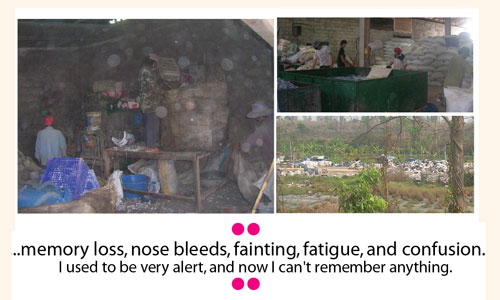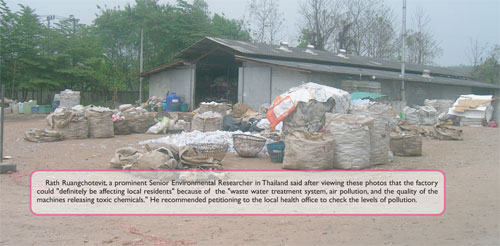
In the heart of a quiet village off the Chiang Mai-Fang Road in Mae Rim, a few kilometres from ‘Baan Kwai’ Buffalo House, close to resorts, schools and housing projects, a plastic recycling factory is located, fronted by walls tall enough to obscure the view of the plant. On closer inspection Anothai Plastic is a sea of synthetic junk, seemingly of every mould, bails stand bulging with buckets, bottles and other containers, while workers, aptly dressed in rags, sort through the muck side by side with scruffy dogs.
“Many people have had skin problems, my daughter has had rashes, I’ve been sick for years . . . three people have died young in the village over there of mysterious diseases,” explained Tiraphon ‘Tor’ Niyom, a fairly stout young man, pointing over to where the local villagers live. “But most of the people are uneducated, they don’t know what’s happening here, only a few of us around have so far made complaints to the local authorities.” Tor owns a restaurant, surrounded by lush gardens where he houses a collection of classic cars. As he relays the story of his fight against the factory his young daughter and his wife sit beside him. He points to his daughter’s arms where she has had skin problems.
 “She had many problems with her skin, and I have had breathing difficulties for years now, so too have others, two of us who live just next to the factory have also had memory loss, nose bleeds, fainting, fatigue, and confusion. I used to be very alert,” he looks at his wife for corroboration and she nods sympathetically, “and now I can’t remember anything.” Tor has approached the factory owner – a policeman by trade – resulting in a tension that exists between the two, although Tor maintains that he fears more from the workers – who he blames for local burglaries – that were brought in to work the factory.
“She had many problems with her skin, and I have had breathing difficulties for years now, so too have others, two of us who live just next to the factory have also had memory loss, nose bleeds, fainting, fatigue, and confusion. I used to be very alert,” he looks at his wife for corroboration and she nods sympathetically, “and now I can’t remember anything.” Tor has approached the factory owner – a policeman by trade – resulting in a tension that exists between the two, although Tor maintains that he fears more from the workers – who he blames for local burglaries – that were brought in to work the factory.

Bringing Back Plastic
Somewhat ironically, in this case, plastics are recycled as a way to reduce dumping and its attendant pollution – it’s also, naturally, a profitable business. Plastic is said to be a molecular zombie, extremely hard to get rid of, or degrade, so its better – we are told – to recycle. Because there are many different compounds of plastic, and they do not mix well, plastics have to be sorted before the recycling process. All plastics should be given numerical codes that denote the various constituents of the compounds. The recycling process usually follows these steps: collecting, sorting, chipping, washing, pelleting. The pellets are then sold on to plastic manufactures that make other various forms of plastic materials. It is during the washing and pelleting process that certain toxins might be released into our environment. From the washing process the residual waste water contaminated with scouring chemicals may be harmful – on a tour of the vicinity Tor pointed to black streams close to the factory – while during the melting process (the precursor to pelleting) – toxins can be released into the air. Excessive land filling does not complement our environment, and plastic recycling, besides a few cases that have gained scant publicity, has evaded criticism. Or possibly, we do not yet fully understand the dangers of recycling – Cambridge University, Department of Biochemical Engineering told Citylife that they were, “not in a position to advise about the toxins that might be released from this process.”
Some stories of plastic recycling pollution have made the broadsheets in the UK, and there have also been reports in India and China where plastics are being recycled without proper checks on hazardous emissions. Closer to home, in Pattaya, Baan Phusai, a plastic recycling factory was closed after residents vigorously petitioned, but not before many had suffered various illnesses. “I lived near that plastic industry and had serious troubles. My son (11) had a dust allergy and chronic sores all over his body,” said one resident.
Tor explained that twice he brought the Or Bor Tor (District Administrative Organisation) to the factory and twice they did nothing, except demand that the factory did not melt during the night – a law Anothai was previously breaking. “They would burn 24 hours a day, we all had to close the windows and doors, your eyes would water and it was hard to breathe.” Any smell at all denotes danger, a Chiang Mai University environmental engineering professor explained, “If you can notice it then it’s dangerous.” The ajarn explained that sometimes the process does leak hazardous toxins. According to Tor, no water or air tests have been performed in the area so far. The ajarn’s colleague pointed out, “Contaminants can pollute the water and during the melting process organic carbons can occur, it’s possible people are getting sick.” They both seemed to think that a local factory in Mae Rim might not have advanced enough machinery to be completely safe. When Tor went in search of the factory plans and machine plans, he was told by the Department of Industrial Planning that they didn’t have the plans.
Ply Pirom, a toxics campaigner for Greenpeace Thailand informed Citylife that there were definite potential dangers in the plastic’s recycling process, that certain plastics when melted release deadly toxins and dioxins into the atmosphere. “Poor technology and pollution control could lead to more impacts on the environment. And if different types of plastic are mixed together when recycled this could lead to larger impacts,” said Ply, adamantly stating that even though recycling was a “preferable solution”, recycling without pollution control measures in the process and without state of the art technology could lead to significant environmental impacts, especially if recycled products contain toxic chemicals. “Certain plastics, especially PVC, often called ‘poison plastic’ when melted release very harmful toxins into the environment, along with a list of other plastics. The recycling process, or sorting, has to be closely monitored.”
“This is a big problem,” said a source at Chiang Mai’s Environmental Office after listening to the details of the story. She seemed somewhat surprised that such a place would have a license, but then on an afterthought she mentioned she had heard of a “dangerous” plastics factory in Mae Rim that also employed illegal workers. She then called a friend at the Provincial Environmental Office. “They have a legal license, but they shouldn’t. In the past a team made up of a public health officer, a provincial, and a local environmental officer visited the factory and in their report to the Industrial Office they advised that the plant be closed down, but nothing happened.” She explained that the Environmental Office doesn’t have the power to close a factory like this, only the Industrial Office does, she also stated that it was either the Or Bor Tor that did not take the team’s advice to the Industrial Office or the latter ignored the request. Regardless of who was at fault, as we speak a factory in Mae Rim, as stated officially in a report, is still causing a possible catastrophe in the area. “The Or Bor Tor has power in the community, what they should do is take that report to the Industrial Office and see action is done,” said the officer.
Citylife will pass on all of our notes and information to national media to follow up on this issue.
UNEP, the Environmental Department of Chiang Mai and Greenpeace all stated that they wanted the factory closed. Unfortunately, it seems there is little they can do. Perhaps if you read this article and feel that you wish to help, you can write letters and bring this issue to the immediate attention of the authorities. A bit of pressure may help.
Provincial Industry Office 053 112317-8
Ministry of Natural resources and Environment Chiang Mai 053 112 725
Greenpeace Southeast Asia
www.greenpeace.or.th
UNEP gilmanj@un.org

Rath Ruangchotevit, a prominent Senior Environmental Researcher in Thailand said after viewing these photos that the factory could “definitely be affecting local residents” because of the “waste water treatment system, air pollution, and the quality of the machines releasing toxic chemicals.” He recommended petitioning to the local health office to check the levels of pollution.